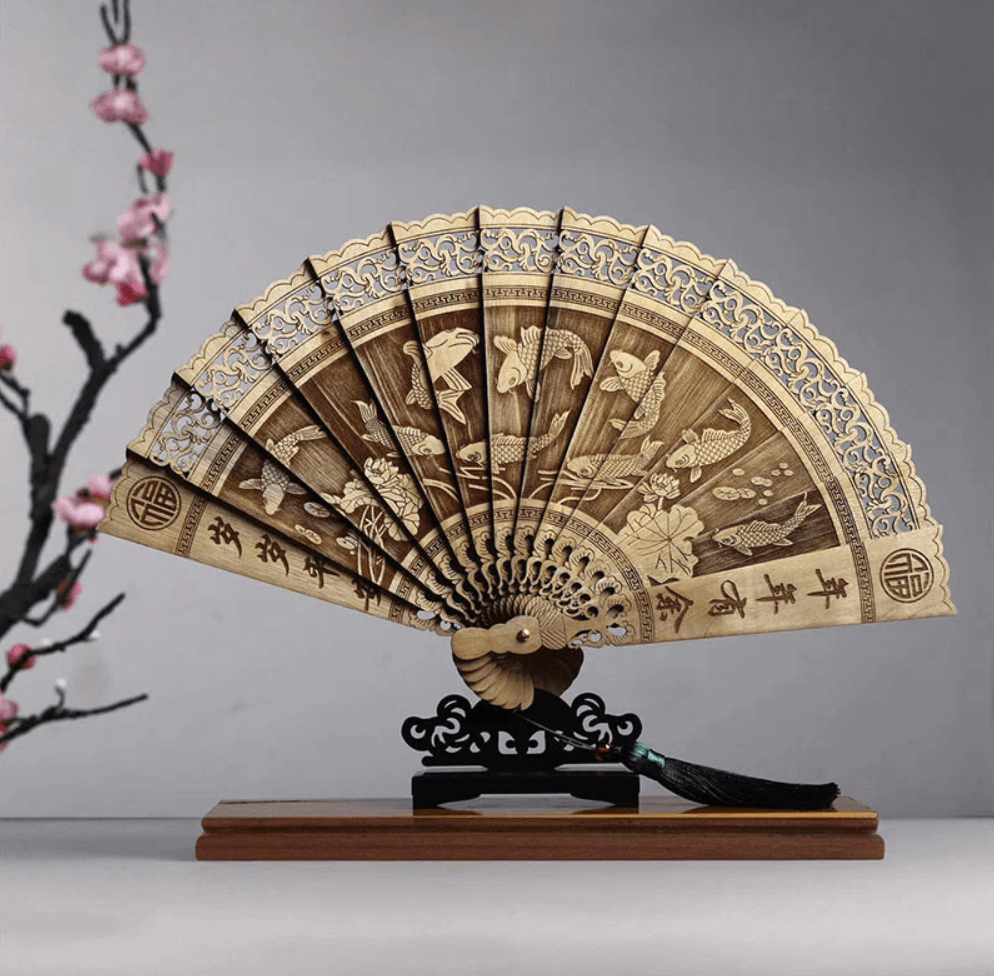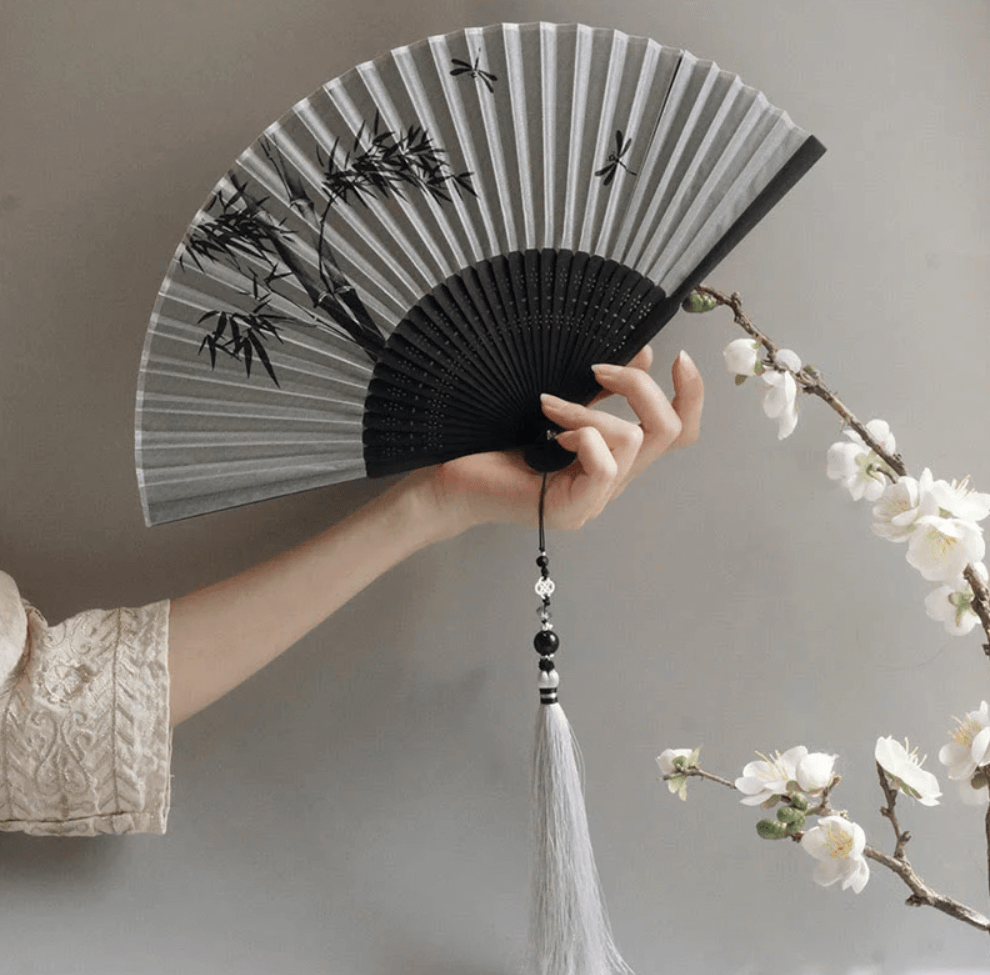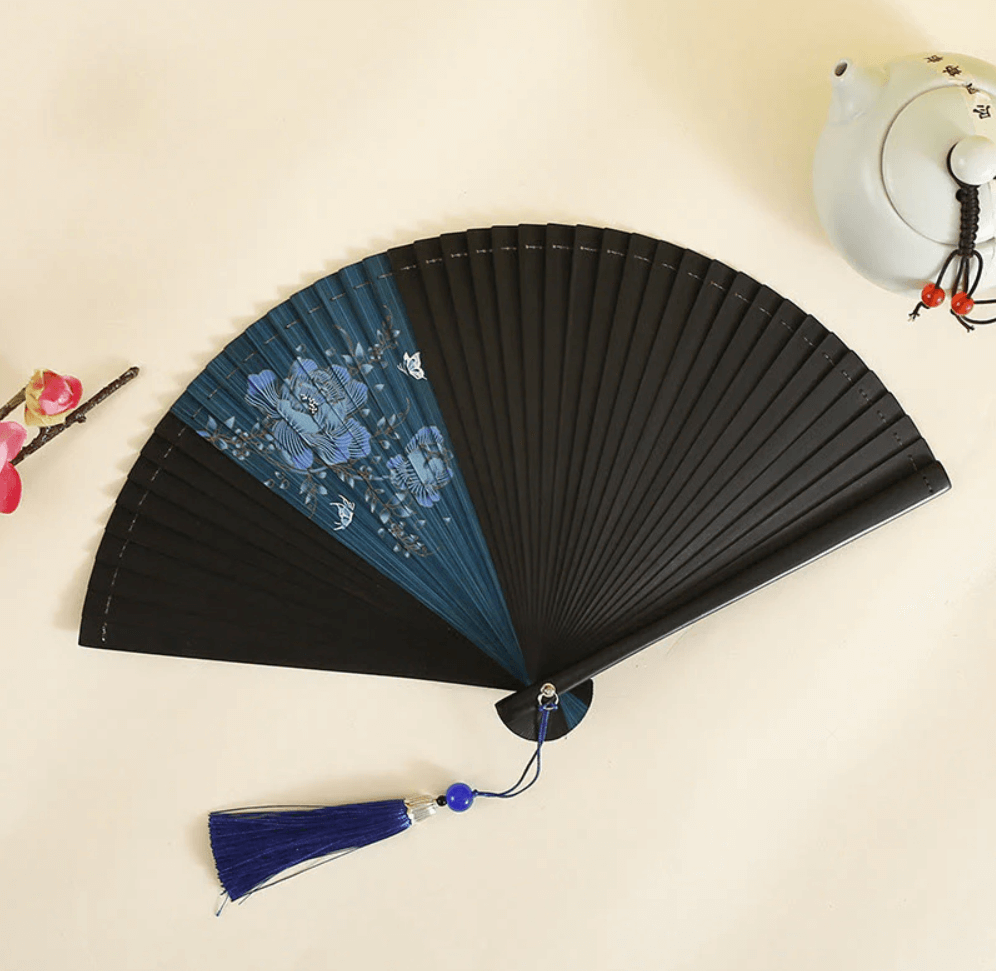Folding Fans: The Flowing Poetry of Oriental Aesthetics
2025-05-14
Introduction: A Thousand Years of Elegance Between Openings and Closures
When the bamboo bone meets the rice paper, when the knife and brush mingle with the ink, a folding fan becomes a miniature universe of oriental aesthetics. It is the landscape hidden in the sleeves of the literati, the time flowing in the fingertips of the craftsmen, and the cultural code that spans thousands of years. From the elegant gatherings and talks in deep houses to the fashion waves of modern T-platforms, the folding fan has always been an elegant gesture that tells the philosophy, poetry and craftsmanship of the Oriental world. Let's follow the texture of the fan bones and open the door to oriental aesthetics.
1.The Beauty of Form: Philosophical Wisdom Between Square and Round
The folding fan opens and closes freely, like a bamboo when it is closed, and like a full moon when it is unfolded, which is in line with the oriental philosophy of “heaven is round and earth is square”. The straight line of the fan bone is sharp and straight, symbolizing the uprightness of a gentleman; the curved line of the fan surface is gentle and smooth, just like a scholar who is gentle as jade. This combination of rigidity and flexibility integrates the Confucian way of mediocrity with the Taoist philosophy of nature. The thinness of bamboo bone, the somberness of sandalwood, the warmth of ivory, the choice of different materials also reflects the wisdom of the creation of “art according to materials”, so that each folding fan becomes a unique work of art.
2.The Beauty of Sculpture: Microcosmic Dryness Under the Knife and Brush
Fan bone carving is an important footnote in the aesthetics of folding fans. Craftsmen use knives as brushes to carve landscapes and figures, flowers, birds, insects and fish on the bamboo bones. The deep relief carving of the pavilions is so clear that it is as if you can swim in the painting; the shallow carving of the orchids and bamboo leaves is as fine as a hair, showing the bones of a gentleman. Staying green carving technique is a masterpiece, bamboo skin Peony for painting, bamboo muscle for the bottom, after years of rubbing, green and yellow colors gradually clear, forming a “five colors of ink” wonderful effect. These carvings are not only a display of craftsmanship, but also a spiritual projection of the literati and elegant people who are in love with the landscape and the spirit of the object.

3.The Beauty of the Fan: Poetic Inhabitation of Ink and Painting
Although the fan is small, but the literati ink world. In the landscape fan, the distant mountains are dyed with light ink, the near trees are outlined with thick brush, and the white space seems to be dense with clouds, showing the meaning of “a thousand miles at hand”; in the bird and flower fan, the peonies are elegantly sketched by brushwork, and the lotus is free from the dust without any bone coloring, and it is inscribed with the sentence “Only peony is a true color of the country! The inscription “Only peony is the true color of the country” or “I have to listen to the sound of the rain on the leftover lotus” makes the poem and the picture reflect each other in an interesting way. There are even literati who use the fan as their letterhead to write their long love, and what flows between the ink marks is not only the words, but also the unique subtle poetic meaning of the Orient.
4.The Beauty of Opening and Closing: A Rhythmic Philosophy of Motion and Stasis
The moment the folding fan opens and closes, it contains the dynamic rhythm of oriental aesthetics. “When the fan unfolds with a snap, it is like the first sight of a goose, which is the spontaneity of “moving like a rabbit”; when it is gently closed, it is like a jade hairpin going into the temples, which reveals the elegance of “being quiet as a virgin”. Literati holding a fan, lightly shaking the wind at leisure, is “bamboo shadow sweeping the dust of the steps not moving” of the leisurely; elegant collection of the Taoist fan pointing painting, into “laughing at the boom and sculls of smoke” of the bones. The rhythm of this static and dynamic transition is in line with the philosophical core of “Zhouyi”, which states that “one yin and one yang is called Tao”, making the folding fan an extension of the body's rhythms and spiritual realm.
5.The Beauty of Accessories: A Code of Elegance in the Details
Fan pendants, fan hoops, fan bags and other accessories are the finishing touches to the aesthetics of the folding fan. A Hetian jade fan pendant, carving “Liu Hai play golden toad” pattern, meaning fortune; amber fan hoop inlaid with silver wire, tattooed as “twining lotus” pattern, symbolizing auspicious continuous. Fan bag made of brocade or woof, embroidered with “plum orchids, bamboo and chrysanthemums” four gentlemen, or “pine and crane” “gourd generation” and other auspicious patterns, both to protect the fan bone, but also highlights the owner's interest. These accessories, like the broken lines of a guqin or the openings of a porcelain vessel, show the truth in the smallest details, bringing the delicacy and refinement of oriental aesthetics to its fullest extent.

6.The Beauty of Culture: A Spiritual Totem Accumulated over a Thousand Years
Folding fans have been used for thousands of years and have long since transcended the realm of practical objects to become a carrier of culture. During the Wei and Jin Dynasties, the literati used the stag fan to talk about the mystery, creating the beauty of the bones; during the Tang and Song Dynasties, the folding fan became the standard for the literati to gather, and Li Bai's poem “Hibiscus in the hand, and the imaginary step tiptoeing to Taiqing” colored the folding fan with the immortal atmosphere; during the Ming and Qing Dynasties, the art of folding fan reached its peak, and the fan works of Tang Yin, Wen Zhengming and other masters are still treasures of the arts today. From the fan of Zhuge Liang on the stage of opera to the fan of Chu Liuxiang in the world of martial arts, the folding fan has long been integrated into the bloodline of oriental culture, and has become a symbol of wisdom, elegance and chivalry.
7.The Beauty of Inheritance: Aesthetic Renewal through Dialogue between the Ancient and the Modern
In contemporary times, the aesthetics of folding fans are being revitalized with new gestures. Designers combine traditional carving techniques with modern minimalism, and the geometric patterns on the bamboo bones collide with the ink fan to create a sense of vanguard; non-genetic inheritance bearers open live broadcasting booths to show the whole process of polishing the fan bones and framing the fan surface, so that young people can feel the artisanal spirit of “slow work makes fine work”; fashion brands launch folding-fan-element clothing and bags, and the fan surface patterns are deconstructed into prints and embroideries, interpreting contemporary narratives of oriental aesthetics on the T-stage. The fan pattern is deconstructed into printing and embroidery, and the contemporary narrative of oriental aesthetics is interpreted on the T platform. This kind of inheritance is not a simple reproduction, but allows the ancient aesthetics of the folding fan to nurture new possibilities in the dialog between the ancient and modern worlds.

Conclusion: Eternal Echoes in the Swaying of Fan Shadows
When we gently unfold a folding fan, the touch is not only the coolness of the bamboo bone and the softness of the paper, but also the temperature of the thousand years of civilization. It has carried poems and paintings on the desk of literati and artists, hidden the wind and clouds in the sleeves of warriors, and now it has a new look in the waves of the times. The beauty of the folding fan is fluid, from the ancient moonlight, has been swaying to the modern light and shadow; is more eternal, because it has long been the Oriental philosophy, poetry and craftsmanship, deeply engraved in the cultural genes. May this touch of fan shadow, always be the most moving elegant footnote when we look back at the tradition.
When the bamboo bone meets the rice paper, when the knife and brush mingle with the ink, a folding fan becomes a miniature universe of oriental aesthetics. It is the landscape hidden in the sleeves of the literati, the time flowing in the fingertips of the craftsmen, and the cultural code that spans thousands of years. From the elegant gatherings and talks in deep houses to the fashion waves of modern T-platforms, the folding fan has always been an elegant gesture that tells the philosophy, poetry and craftsmanship of the Oriental world. Let's follow the texture of the fan bones and open the door to oriental aesthetics.
1.The Beauty of Form: Philosophical Wisdom Between Square and Round
The folding fan opens and closes freely, like a bamboo when it is closed, and like a full moon when it is unfolded, which is in line with the oriental philosophy of “heaven is round and earth is square”. The straight line of the fan bone is sharp and straight, symbolizing the uprightness of a gentleman; the curved line of the fan surface is gentle and smooth, just like a scholar who is gentle as jade. This combination of rigidity and flexibility integrates the Confucian way of mediocrity with the Taoist philosophy of nature. The thinness of bamboo bone, the somberness of sandalwood, the warmth of ivory, the choice of different materials also reflects the wisdom of the creation of “art according to materials”, so that each folding fan becomes a unique work of art.
2.The Beauty of Sculpture: Microcosmic Dryness Under the Knife and Brush
Fan bone carving is an important footnote in the aesthetics of folding fans. Craftsmen use knives as brushes to carve landscapes and figures, flowers, birds, insects and fish on the bamboo bones. The deep relief carving of the pavilions is so clear that it is as if you can swim in the painting; the shallow carving of the orchids and bamboo leaves is as fine as a hair, showing the bones of a gentleman. Staying green carving technique is a masterpiece, bamboo skin Peony for painting, bamboo muscle for the bottom, after years of rubbing, green and yellow colors gradually clear, forming a “five colors of ink” wonderful effect. These carvings are not only a display of craftsmanship, but also a spiritual projection of the literati and elegant people who are in love with the landscape and the spirit of the object.

3.The Beauty of the Fan: Poetic Inhabitation of Ink and Painting
Although the fan is small, but the literati ink world. In the landscape fan, the distant mountains are dyed with light ink, the near trees are outlined with thick brush, and the white space seems to be dense with clouds, showing the meaning of “a thousand miles at hand”; in the bird and flower fan, the peonies are elegantly sketched by brushwork, and the lotus is free from the dust without any bone coloring, and it is inscribed with the sentence “Only peony is a true color of the country! The inscription “Only peony is the true color of the country” or “I have to listen to the sound of the rain on the leftover lotus” makes the poem and the picture reflect each other in an interesting way. There are even literati who use the fan as their letterhead to write their long love, and what flows between the ink marks is not only the words, but also the unique subtle poetic meaning of the Orient.
4.The Beauty of Opening and Closing: A Rhythmic Philosophy of Motion and Stasis
The moment the folding fan opens and closes, it contains the dynamic rhythm of oriental aesthetics. “When the fan unfolds with a snap, it is like the first sight of a goose, which is the spontaneity of “moving like a rabbit”; when it is gently closed, it is like a jade hairpin going into the temples, which reveals the elegance of “being quiet as a virgin”. Literati holding a fan, lightly shaking the wind at leisure, is “bamboo shadow sweeping the dust of the steps not moving” of the leisurely; elegant collection of the Taoist fan pointing painting, into “laughing at the boom and sculls of smoke” of the bones. The rhythm of this static and dynamic transition is in line with the philosophical core of “Zhouyi”, which states that “one yin and one yang is called Tao”, making the folding fan an extension of the body's rhythms and spiritual realm.
5.The Beauty of Accessories: A Code of Elegance in the Details
Fan pendants, fan hoops, fan bags and other accessories are the finishing touches to the aesthetics of the folding fan. A Hetian jade fan pendant, carving “Liu Hai play golden toad” pattern, meaning fortune; amber fan hoop inlaid with silver wire, tattooed as “twining lotus” pattern, symbolizing auspicious continuous. Fan bag made of brocade or woof, embroidered with “plum orchids, bamboo and chrysanthemums” four gentlemen, or “pine and crane” “gourd generation” and other auspicious patterns, both to protect the fan bone, but also highlights the owner's interest. These accessories, like the broken lines of a guqin or the openings of a porcelain vessel, show the truth in the smallest details, bringing the delicacy and refinement of oriental aesthetics to its fullest extent.

6.The Beauty of Culture: A Spiritual Totem Accumulated over a Thousand Years
Folding fans have been used for thousands of years and have long since transcended the realm of practical objects to become a carrier of culture. During the Wei and Jin Dynasties, the literati used the stag fan to talk about the mystery, creating the beauty of the bones; during the Tang and Song Dynasties, the folding fan became the standard for the literati to gather, and Li Bai's poem “Hibiscus in the hand, and the imaginary step tiptoeing to Taiqing” colored the folding fan with the immortal atmosphere; during the Ming and Qing Dynasties, the art of folding fan reached its peak, and the fan works of Tang Yin, Wen Zhengming and other masters are still treasures of the arts today. From the fan of Zhuge Liang on the stage of opera to the fan of Chu Liuxiang in the world of martial arts, the folding fan has long been integrated into the bloodline of oriental culture, and has become a symbol of wisdom, elegance and chivalry.
7.The Beauty of Inheritance: Aesthetic Renewal through Dialogue between the Ancient and the Modern
In contemporary times, the aesthetics of folding fans are being revitalized with new gestures. Designers combine traditional carving techniques with modern minimalism, and the geometric patterns on the bamboo bones collide with the ink fan to create a sense of vanguard; non-genetic inheritance bearers open live broadcasting booths to show the whole process of polishing the fan bones and framing the fan surface, so that young people can feel the artisanal spirit of “slow work makes fine work”; fashion brands launch folding-fan-element clothing and bags, and the fan surface patterns are deconstructed into prints and embroideries, interpreting contemporary narratives of oriental aesthetics on the T-stage. The fan pattern is deconstructed into printing and embroidery, and the contemporary narrative of oriental aesthetics is interpreted on the T platform. This kind of inheritance is not a simple reproduction, but allows the ancient aesthetics of the folding fan to nurture new possibilities in the dialog between the ancient and modern worlds.

Conclusion: Eternal Echoes in the Swaying of Fan Shadows
When we gently unfold a folding fan, the touch is not only the coolness of the bamboo bone and the softness of the paper, but also the temperature of the thousand years of civilization. It has carried poems and paintings on the desk of literati and artists, hidden the wind and clouds in the sleeves of warriors, and now it has a new look in the waves of the times. The beauty of the folding fan is fluid, from the ancient moonlight, has been swaying to the modern light and shadow; is more eternal, because it has long been the Oriental philosophy, poetry and craftsmanship, deeply engraved in the cultural genes. May this touch of fan shadow, always be the most moving elegant footnote when we look back at the tradition.

